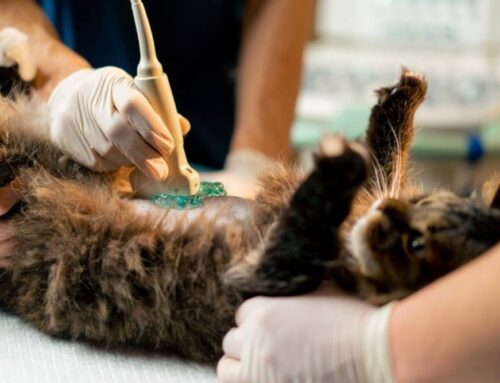As a pet owner, your job is to care for your pet and make the difficult decisions necessary when their quality of life (QOL) is no longer acceptable. QOL is a term used to describe how your pet handles their day to day life, and knowing how to accurately assess this factor can help prevent needless suffering as your pet approaches their final days. To ensure your pet enjoys life for as long as possible, our Village Animal Hospital team explains how you can make this determination.
HHHHHMM quality of life scale for pets
Dr. Alice Villalobos, a veterinary oncologist, developed a QOL scale to help pet owners better assess their pet’s wellbeing. This scale examines seven categories, with each parameter scored from 1 to 10. A score of 10 is ideal. If a pet scores above 35, their QOL is considered reasonable, and continuing care is justified. If their score is below 35, decisions about humane euthanasia should be addressed. The parameters evaluated include:
- Hurt — The ability to control a pet’s pain, including their ability to breathe, is a crucial QOL factor. A pet may need pain medications or other main management therapies to maintain their comfort.
- Hydration — Many pets with health problems don’t drink enough, and may require subcutaneous fluids to help maintain their hydration.
- Hygiene — Senior pets commonly lose interest in grooming themselves, or they may lack the mobility to groom themselves appropriately. In these cases, frequent grooming is necessary to remove waste material from your pet’s coat and to ensure bed ridden pets don’t develop bedsores.
- Happiness — You know your pet better than anyone, which means you know how they behave when they are happy. Maybe your dog wags their tail when you show them their favorite ball, or your cat winds their way enthusiastically around your legs when you turn on the can opener. If your pet isn’t exhibiting these tell-tale signs, they may not be experiencing joy in life.
- Mobility — Pets who cannot move around on their own can experience mental and physical anguish. A pet who only needs assistance going up and down stairs may still enjoy a good quality of life, but pets who are bedridden often suffer depression and feel isolated.
- More good days than bad — When your pet has more bad days than good, their QOL is compromised.
JOURNEYS quality of life scale
Dr. Katie Hilst developed another QOL scale that some pet owners find more intuitive than the HHHHHMM scale. Eight categories are graded from 1 to 10, with 10 being ideal. A score of 80 means your pet’s QOL is excellent, and a score of 8 means their suffering warrants consideration of euthanasia. Categories include:
- Jumping and mobility — Scoring examples include:
- 1 — Your pet can’t stand or walk without help.
- 5 — Your pet can move around if they are given pain medication, and they can perform about half their old activities.
- 10 — Your pet is fully active and enjoys their normal activities.
- Ouch and pain — Scoring examples include:
- 1 — Your pet exhibits pain while on high doses of pain medication.
- 5 — Your pet receives pain medication that helps 75% or more of the time.
- 10 — Your pet does not appear painful.
- Uncertainty and understanding — Scoring examples include:
- 1 — Your pet’s medical condition is unpredictable, and sudden catastrophic events may occur.
- 5 — Your pet’s condition is changing but currently stable, and treatment adjustments can be made as needed.
- 10 — Your pet has no health issues.
- Respiration and breathing — Scoring examples include:
- 1 — Your pet suffers frequent coughing or open-mouth breathing episodes, and can’t eat or drink because they have difficulty breathing.
- 5 — Your pet occasionally coughs, wheezes, or exhibits exercise intolerance. These episodes are short and medication alleviates the signs.
- 10 — Your pet breathes normally at all times.
- Neatness and hygiene — Scoring examples include:
- 1 — Your pet can’t control their elimination or they can’t move themselves afterward, so they lie in their waste, and may have pressure sores because they cannot move.
- 5 — Your pet needs assistance to relieve themselves, but can wait for assistance. They can keep themselves clean with your help.
- 10 — Your pet has no issues relieving or grooming themselves.

- Eating and drinking — Scoring examples include:
- 1 — Your pet refuses to eat or drink, and may have frequent diarrhea or vomiting.
- 5 — Your pet eats their normal food and portions, but they are slow to finish their meal.
- 10 — Your pet eats and drinks normally.
- Your capabilities — Scoring examples include:
- 1 — You feel overwhelmed by your pet’s needs and are constantly worried.
- 5 — You are concerned about your pet’s needs, but you can manage them.
- 10 — You are not concerned about meeting your pet’s needs.
- Social ability — Scoring examples include:
- 1 — Your pet doesn’t spend time with your family, and no longer enjoys attention.
- 5 — Your pet spends some time with your family, but they get irritated if disturbed when trying to rest.
- 10 — Your pet actively seeks out attention.
Accurately assessing your pet’s QOL is important to ensure they don’t suffer needlessly. If you are concerned about your pet’s QOL, contact our Village Animal Hospital team, so we can help you navigate the situation.








Leave A Comment